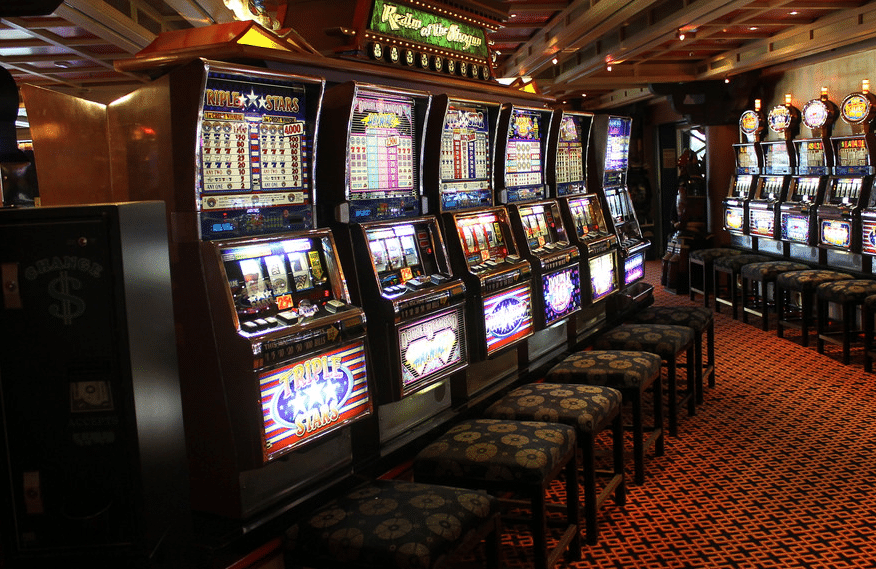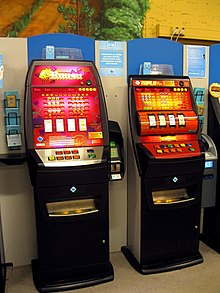Probably every single one of us has seen a slot machine at least once in our lives and besides the themes and colors they all look and sound the same, but are they? That is the question to ask!
John Grochowski is the best-selling author of The Craps Answer Book, The Slot Machine Answer Book and The Video Poker Answer Book. His weekly column is syndicated to newspapers and Web sites, and he contributes to many of the major magazines and newspapers in the gaming field, including Midwest Gaming and Travel, Slot Manager, Casino Journal, Strictly Slots and Casino Player. Apr 12, 2017 Players sometimes believe that winning on a Class II slot machine is easier than winning on a Class III machine. Class II machines are similar to Class III machines, each machine has a pull handle or touch screens and are relatively the same size. That stipulation led to electronic versions of the game of bingo, which eventually took the form of Class II-style slot machines, known as Bingo Games. The Class II Bingo Games would essentially be a game of bingo, with prizes drawn from the overall money wagered. Those prizes, however, would be displayed as reel results on the slot machines.
Slot machines are usually divided into two groups, Class II and Class III machines. It is more than just easy to distinguish them when you known this simple trick; just check out the corners of the electronic display and if you find a little bingo card there then you can be sure that you are playing a Class II slot machine. Now that you know how to guess what kind of slot you are playing on, let us move on to understanding what the difference between them actually is.
Who are you playing against?!
Now that is the biggest difference between Class II and Class III slot machines. Let us discuss Class II slots first; in this case you are playing against other players like you but the set of prizes are quite limited. This type of slots basically mimic the real game of Bingo. The game starts by hitting the spin button and you automatically join in the process. Certain number of slot machines are linked to the central processing computer that controls the game and calls out numbers and winner accordingly. One major difference between real-life Bingo and Class II slot machines is that you do not have to pay attention to the caller and search for the numbers on your card. At the end of the play, casino takes part of the income from the play and gives out the rest as cash prize to the winners.
You versus the Casino
This is the main principle of the Class III slot machines. You are simply playing against the casino. The slot machines are set up in a manner that it hold a certain part of the money played and redistributes the rest to the players. So, it is all about timing and luck. On the contrary to the Class II slot machines, Class III machines can make you a big winner.


To sum it up, Class II slot machines are played among some players simultaneously who battle for a single prize, while Class III machines can be played by lots of different people at different times and they all seek for the payout from a single machine.
Antoine Foxx
33 year old male. Has visited Las Vegas several times as well as other great gambling places. Always having a good time. After having a little girl, he couldn’t travel as much so he started enjoying online gaming. Antoine is always looking for something different and interesting. Part time rock star but full time computer geek, he never seems to guarantee a balanced life. Enjoys Cajun food a lot!
Latest posts by Antoine Foxx (see all)
Many gambling enthusiasts in the United States are at least vaguely familiar with the Indian Gaming Regulatory Act, US law Pub.L. 100–497, 25 U.S.C. § 2701.
Passed in 1988, this federal law established how Indian (Native American) gaming would be managed and regulated. The act included definitions for 3 types or classes of gambling games. They are usually referred to as:
- Class I games
- Class II games
- Class III games

Congress passed the law to help Native American tribes and nations improve their economic status after more than a century of oppression and exclusion in mainstream US society. Many Native American groups wanted to build land-based casinos, which would not only attract tourists but create jobs.
There was considerable resistance to this movement in many states, most of which did not allow gambling of any kind. To help resolve the conflicts and provide some clarity between treaties, state law, and federal law, the US government established a framework that eliminated some barriers to Native American investment in gambling industries. The law also provided some regulatory limits to respect state laws.
The Indian Gaming Regulatory Act introduced some confusion into the worldwide lexicon of gambling games because the distinctions are only observed within US jurisdictions. Other nations regulate gambling with different definitions.
But as the internet became a worldwide communications network in the 1990s and 2000s, most of the content published about gambling dealt with US law and casinos. Although non-US casinos have to observe their own laws and regulations, players who research gambling law on the internet must be careful to distinguish between USA gambling definitions and other gambling definitions.
What Are the 3 Classes of Gambling Games?
Class I gambling includes all traditional Native American gambling games, most of which are only used for ceremonial purposes or in the contexts of cultural-specific celebrations and ceremonies. These games, which are only available at small stakes, are completely regulated by the Native American tribes and nations.
Class II gambling includes all variations of bingo games, player-vs-player card games like poker (where the house does not play a hand in the game), tip jars, pull-tab games, punch card games, and anything similar. Some people mistakenly include lottery games in this category, but the law clearly excludes state-run lotteries and similar games from Class II.

People Playing Slots In Vegas
Class III gambling consists of everything that is not included under Class I gambling or Class II gambling. That means the lottery games you play are Class III gambling games. Slot games, roulette, dice games, and card games like blackjack where the house is also a player all fall under the Class III gambling games category.
So How Can There Be Class II Slot Machine Games?
If you’ve ever visited a Native American casino–like the Winstar Casino in Oklahoma, you’ve almost certainly played some Class II slot machine games. They look much like traditional slot machine games. They have 3 to 5reels with symbols on them, they pay jackpots, and they do everything else you expect of a slot game.
And yet, they are not slot machine games.
A clever company in Franklin, TN, known as Video Gaming Technologies, or VGT, developed electronic bingo games for Native American casinos that use the results of those bingo games to emulate slot game action.
In other words, the slot machine cabinets contain two screens, one that displays the results of the bingo game and one that displays the results of the simulated slot game. This dual visualization of the gambling game takes advantage of the fact that at the core of all gambling games is a simple principle:
You’re making a wager on an unknown outcome. What the Class II slot games do is take the result of the bingo game to determine what happens in the slot game.
What’s cool about this approach is that VGT was able to add bonus games to the bingo games that work like slot machine bonus games. They’ve developed a huge selection of bingo games that play like slot games. VGT is so successful they were acquired by Aristocrat Leisure Limited in 2014, although the former VGT still operates as an independent subsidiary company of Aristocrat.
How Do Class III Slot Machine Games Work?
The key to the hybridization of bingo and slot machine games is the Random Number Generator. Mathematicians have been developing algorithms to calculate unpredictable numbers for hundreds of years. For a detailed look at the concept, read “How Do Random Number Generators Work?” on Jackpots Online. Although the RNG does not produce a truly random number, in typical circumstances the number is random enough. Even so, slot game designers use random numbers in multiple ways.
Before I continue, I should mention that US law requires slot game designers to work by different rules from other countries’ slot games. In the United Kingdom, for example, the outcome of a slot game is determined by a single random number. In the United States, the outcome of the Class III slot game is determined by several random numbers.
To begin with, an electronic slot machine or online slot game uses a software concept called an array to represent each reel. Computer arrays work like rows of boxes, where each box holds one piece of information. The arrays for slot reels may have anywhere from 22 to 256 slots. Each slot in the array holds a symbol marker that tells the slot machine game what to display on the screen.
Slot game designers use special algorithms to decide how often each type of symbol should appear in each slot array. The frequency of the symbol’s use in the array and the size of the array determine how likely or unlikely it is for any single spin of the slot game reels to create one or more winning combinations. The game’s software may award prizes for one or more winning combinations at a time, depending on how many pay lines the game offers.
The random number generator produces a new number every few milliseconds. The number is placed in a temporary memory location called a register. The slot game software grabs the latest random number from the register and uses that to determine what happens next. For example, a 5 reel slot game needs 5 random numbers to pick how many slot positions will be spun on each reel before the reels stop in new locations. If the slot game awards random prizes like progressive jackpots, these are determined by additional random numbers.
How Class II Slot Machine Games Differ from Class III Slot Machine Games
What VGT did was create bingo game software that determines the actual prizes awarded to players.
But to make the bingo games look like slot games, they used the bingo game’s random results as if they are the random numbers that Class III slot games use.
To ensure that the slot game winning combinations match the bingo game prize values the VGT games work more like slot games in the United Kingdom. The game determines what prize was won and then creates a short video simulation of the slots landing on that winning combination.
Conclusion

How do class II slot machines work?
Either way, the slot games award prizes on a random basis. You could say that US gaming laws are paranoid in that Class III slot game software is required to closely emulate the physical spinning of slot reels. In fact, physical slot reel games have been displaying results of these virtual, in-memory array games for more than 20 years. So even when you see physical reels spinning, their stop positions have already been determined within microseconds of your pressing SPIN.
Playing Type 2 Slots Games
The Class II slot gaming experience is a fun gaming experience.
But the bingo game is displayed on a small screen, because VGT’s designers have found that players don’t enjoy looking at bingo patterns as much as they enjoy looking at 3 to 5 reels spinning and stopping on various symbols.
Playing Type 2 Slots Slot Machines
For the player, what matters is that they’re gambling for real money on an unpredictable outcome–and they can enjoy an entertaining evening with friends or loved ones.